
The bulbuls are members of a family, Pycnonotidae, of medium-sized passerine songbirds, which also includes greenbuls, brownbuls, leafloves, and bristlebills. The family is distributed across most of Africa and into the Middle East, tropical Asia to Indonesia, and north as far as Japan. A few insular species occur on the tropical islands of the Indian Ocean. There are over 150 species in 32 genera. While different species are found in a wide range of habitats, the African species are predominantly found in rainforest, whereas Asian bulbuls are predominantly found in more open areas.

The buntings are a group of Old World passerine birds forming the genus Emberiza, the only genus in the family Emberizidae. The family contains 45 species. They are seed-eating birds with stubby, conical bills.
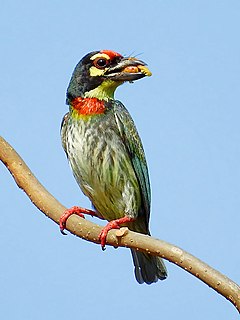
The coppersmith barbet, also called crimson-breasted barbet and coppersmith, is an Asian barbet with crimson forehead and throat, known for its metronomic call that sounds similar to a coppersmith striking metal with a hammer. It is a resident bird in the Indian subcontinent and parts of Southeast Asia. It carves out holes inside a tree to build its nest. It is predominantly frugivorous, but has been observed eating insects, especially winged termites.

The white-cheeked barbet or small green barbet is a species of Asian barbet found in southern India. It is very similar to the more widespread brown-headed barbet, but this species has a distinctive supercilium and a broad white cheek stripe below the eye and is found in the forest areas of the Western Ghats, parts of the Eastern Ghats and adjoining hills. The brown-headed barbet has an orange eye-ring but the calls are very similar and the two species occur together in some of the drier forests to the east of the Western Ghats. Like all other Asian barbets, they are mainly frugivorous, and use their bills to excavate nest cavities in trees.
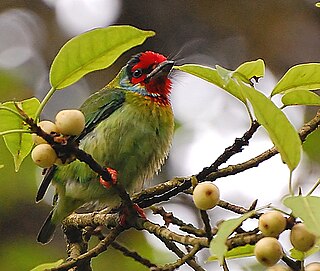
The Malabar barbet is an Asian barbet native to the Western Ghats in India. It was formerly treated as a race of the crimson-fronted barbet. It overlaps in some places with the range of the coppersmith barbet and has a similar but more rapid call.

The neotropical parrots or New World parrots comprise about 150 species in 32 genera found throughout South and Central America, Mexico, and the Caribbean islands. They are also present on a few Pacific islands such as the Galápagos. Among them are some of the most familiar and iconic parrots, including the blue and gold macaw, sun conure, and yellow-headed amazon.
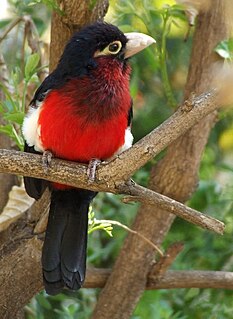
The African barbets are birds in the family Lybiidae. There are 43 species ranging from the type genus Lybius of forest interior to the tinkerbirds (Pogoniulus) of forest and scrubland. They are found throughout sub-Saharan Africa, with the exception of the far south-west of South Africa.

The great barbet is an Asian barbet native to the Indian sub-continent and Southeast Asia, where it inhabits foremost forests up to 3,000 m (9,800 ft) altitude. It has been listed as Least Concern on the IUCN Red List since 2004 because of its wide distribution.

The golden-throated barbet is an Asian barbet native to Southeast Asia, where it inhabits foremost forests between 900 and 2,700 m altitude. It is listed as Least Concern on the IUCN Red List because of its wide distribution and stable population.

The blue-eared barbet is a barbet in the Megalaimidae family native to mainland Southeast Asia. Because of its wide distribution and stable population it is listed as Least Concern on the IUCN Red List.

The black-browed barbet is an Asian barbet native to Peninsular Malaysia and Sumatra, where it inhabits foremost forests between 600 and 2,000 m altitude. It is listed as Least Concern on the IUCN Red List because of its wide distribution and stable population.

The golden-whiskered barbet is an Asian barbet species native to the western Malay Archipelago, where it inhabits foremost forests up to 1,500 m (4,900 ft) elevation. It has been listed as Least Concern on the IUCN Red List since 2004 because of its wide distribution.

The red-vented barbet is an Asian barbet native to Laos, Vietnam and Cambodia, where it inhabits subtropical or tropical moist lowland forest and subtropical or tropical moist montane forests.
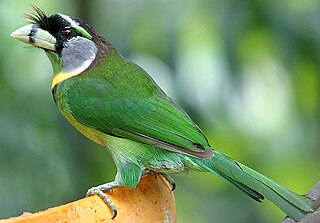
Psilopogon is a genus of Old World barbets that used to include only a single species, the fire-tufted barbet. Results of molecular phylogenetic analyses indicate that the genus is nested within an evolutionary branch consisting of Asian barbets that were formerly placed in the genus Megalaima proposed by George Robert Gray in 1841. Since Psilopogon was proposed by Salomon Müller already in 1835, this name takes priority.

The Taiwan barbet is a species of bird endemic to the country of Taiwan.
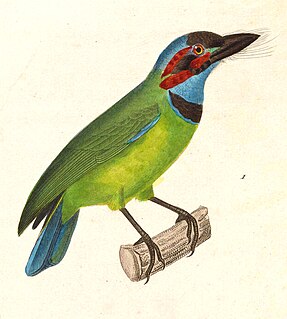
The black-eared barbet is a barbet in the family Megalaimidae native to Peninsular Malaysia, Sumatra and Borneo. It inhabits shrubland and forest up to an altitude of 1,200 m (3,900 ft). Because of its large range it is listed as least concern on the IUCN Red List.



















